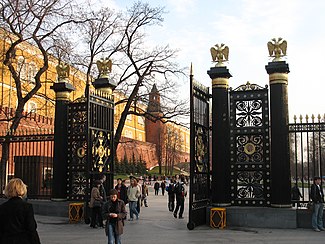Alexander Garden
| Alexander Garden Александровский сад |
|
|---|---|
 |
|
| Type | Urban park |
| Coordinates | 55°45′09″N 37°36′50″E / 55.75250°N 37.61389°ECoordinates: 55°45′09″N 37°36′50″E / 55.75250°N 37.61389°E |
| Created | 1823 |
| Status | Open all year |
Alexander Gardens (Russian: Александровский сад) was one of the first urban public parks in Moscow, Russia. The park comprises three separate gardens, which stretch along all the length of the western Kremlin wall for 865 metres (2,838 ft) between the building of the Moscow Manege and the Kremlin.
After the Napoleonic Wars, Tsar Alexander I ordered architect Osip Bove to reconstruct parts of the city which had been destroyed by French troops. Bove laid out a new garden from 1819-1823, on the site of the riverbed of the Neglinnaya River, which was channeled underground.
Towards the main entrance to the park is the Tomb of the Unknown Soldier with an eternal flame brought from the Field of Mars in Leningrad. Created in 1967, it contains the body of a soldier who fell during the Great Patriotic War at the kilometer 41 marker of Leningradskoe Shosse, the nearest point the forces of Nazi Germany penetrated towards Moscow. Post Number One, where the honor sentinels stand on guard, used to be located in front of Lenin's Mausoleum, but was moved to the Tomb of The Unknown Soldier in the 1990s. The middle section of the upper garden contains a faux ruined grotto built underneath the Middle Arsenal Tower. Although not constructed until 1841, this was part of Bove's original design. The garden's cast iron gate and grille were designed to commemorate the Russian victories over Napoleon, and its rocks are rubble from buildings destroyed during the French occupation of Moscow.
...
Wikipedia
